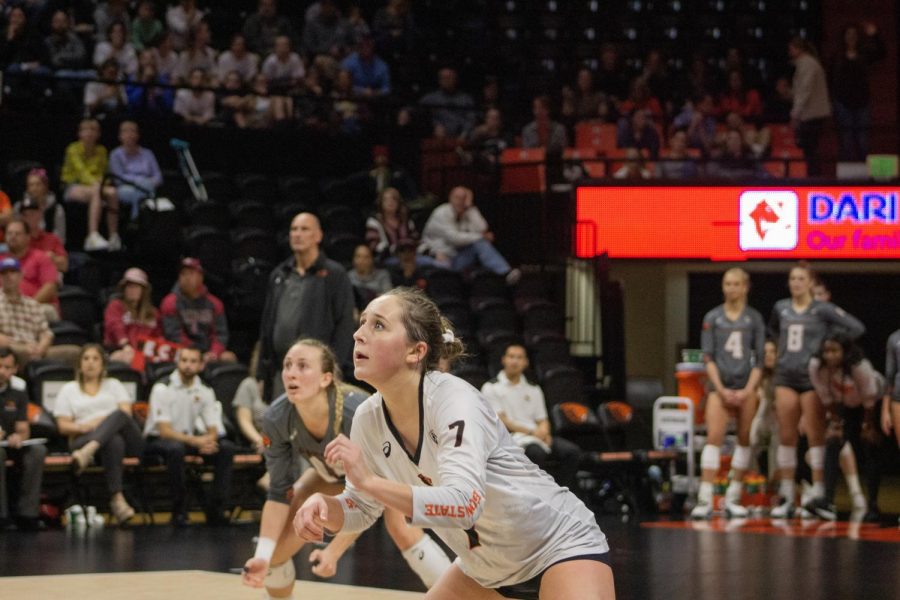Sports Breakdown: Volleyball
April 14, 2020
Volleyball is a sport that consists of two separate teams of six players who are separated by a net, similar to tennis. Players used their hands in volleyball to hit the ball back and forth over the high net. The goal is to knock the ball onto the opposing team’s court, before it can be returned through the air by hand.
Players may not hold the ball at any point, except on serves, which begin the play of the game, once again similarly to tennis. A team is not allowed to touch the ball more than three times before it is returned over the net and each player may only touch the ball once at a time.
Volleyball has sprouted in America, and become one of the most popular sports in the nation, especially for females. It was introduced to the world’s biggest stage in the 1964 Olympic games in Tokyo, Japan and has made its imprint worldwide.
American beach volleyball players Kerri Walsh Jennings and Misty May-Treanor have helped popularize the sport as of late, dominating the doubles in the Olympics, which is a different form of the game. Regardless of the form, this shows the reaches of the game and the effect it has on the world of sports. It is a game that showcases action, athleticism, physicality, strategy and consistent excitement.
Games of volleyball are called matches, and within these matches, there are sets which decide the overall outcome of the game. There are typically five sets in a match, with the winner being deemed by the most wins out of the five possible outcomes.
There are basic skills in volleyball that are crucial for a team’s possibility of winning. These
skills though are far from basic, requiring countless hours of practice, discipline and oftentimes natural talent. The skills typically include passing, blocking, digging, setting, serving and spiking. If these skills can be executed in an effective manner, a team will likely have a high chance in winning.
Glossary:
Passing: While is fairly self-explanatory, good passing often comes from good teamwork, and this may be one of the most overlooked details in the game. Players may not pass more than three times per possession, but the passing will give a team’s offense the ability to shift the defense off of their position for the possibility of a point.
Blocking: Blocking is when a player reaches over the high net and stops a shot back from the other team, but they may not reach over the net. This skill is not taught as much as it can be natural, especially for taller individuals.
Digging:A dig is when a player has to reach and go low to retrieve and bump back a ball, or set it because of this athletic play.
Setting: This is practically an assist, as a player reaches overhand to set up a play for their team.
Serving: This can often be under handed volley, but can also be overhanded, and for the experts the player may even jump to create extra force behind their strike. The server must stand behind a line for the whole time they serve, and then may proceed to play with the set. The ball must be served within the proper line areas on the opposite side of the server and net.
Spiking: This is where a player jumps up to hit a ball with force to the opponents to gain a point. Spikes are difficult to return because of the force being exerted into the shot.
Setter: The player whose position is like the point guard or quarterback. They run the offense, and direct decisions. They play in the front and back of the court needing to be ready to do essentially everything.
Outside Hitter/Left Side Hitter: This player attacks from the left side of the volleyball court, from the vantage point of facing the net. This player is typically the focal point of the offense and completes many of the attack hits on a regular basis. They are responsible for being a go-ahead hitter, passing, blocking and adjusting from the front and back rows.
Middle Hitter: This player can also be considered a blocker, as it is often the team’s tallest player. The height becomes an advantage when they are in the front middle in front of the net enforcing an attack and defensive mentality oftentimes.
Opposite Hitter/Right Side Hitter: This position can also be considered an opposite hitter, as they play near the right side of the court. This player is often versatile so they can play both offense and defense. They should also be able to hit the ball a fair distance because of where they may be positioned on the floor.
Libero/Defensive Specialist: As the name describes, this player is a defensive specialist, and wears a contrasting color from the rest of their team. This player does nearly everything, but cannot block or attack the ball when it is above the net height. This player is necessary for digs and sets, and a team leader overall.
Role Model Players:
Kerri Walsh Jennings: Beach volleyball American women’s volleyball legend; 3-time Olympic gold medalist.
Misty May-Treanor: Beach volleyball American women’s volleyball legend; 3-time Olympic gold medalist.
Gilberto Amauri de Godoy Filho: Former Brazilian outside hitter; gold medalist at 2004 Olympics in Athens.
Grace Massey: Oregon State senior defensive specialist and libero from Beaverton, Ore.
Haylie Bennet: Oregon State senior right side player. 2019 All-Conference Honorable Mention from Philomath, Ore.











































































































